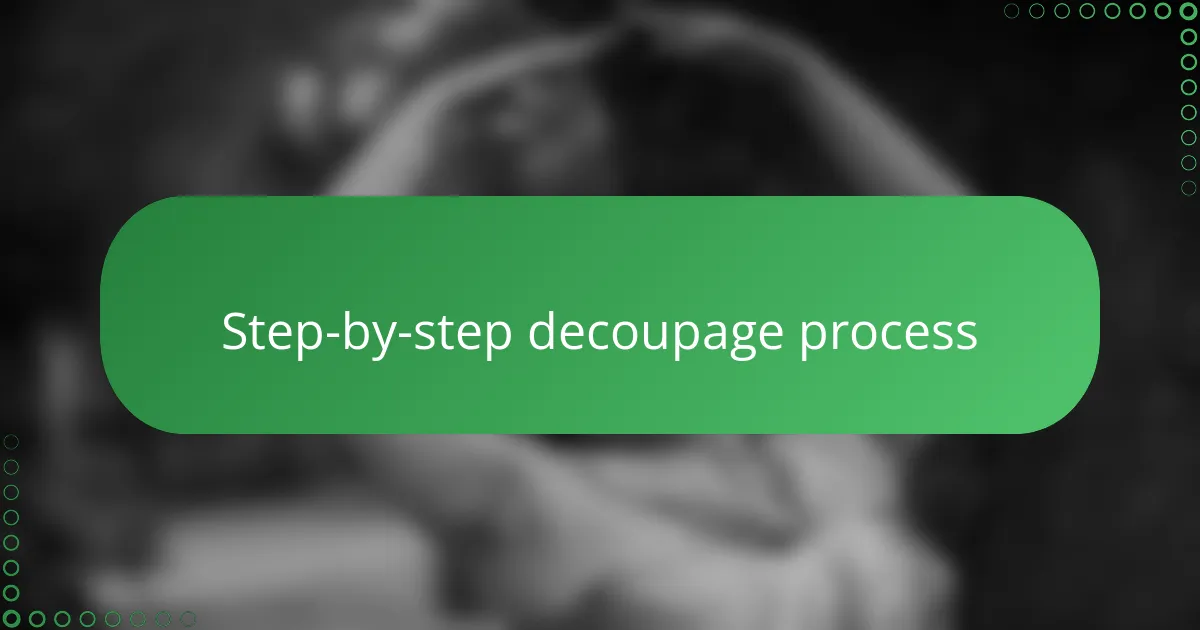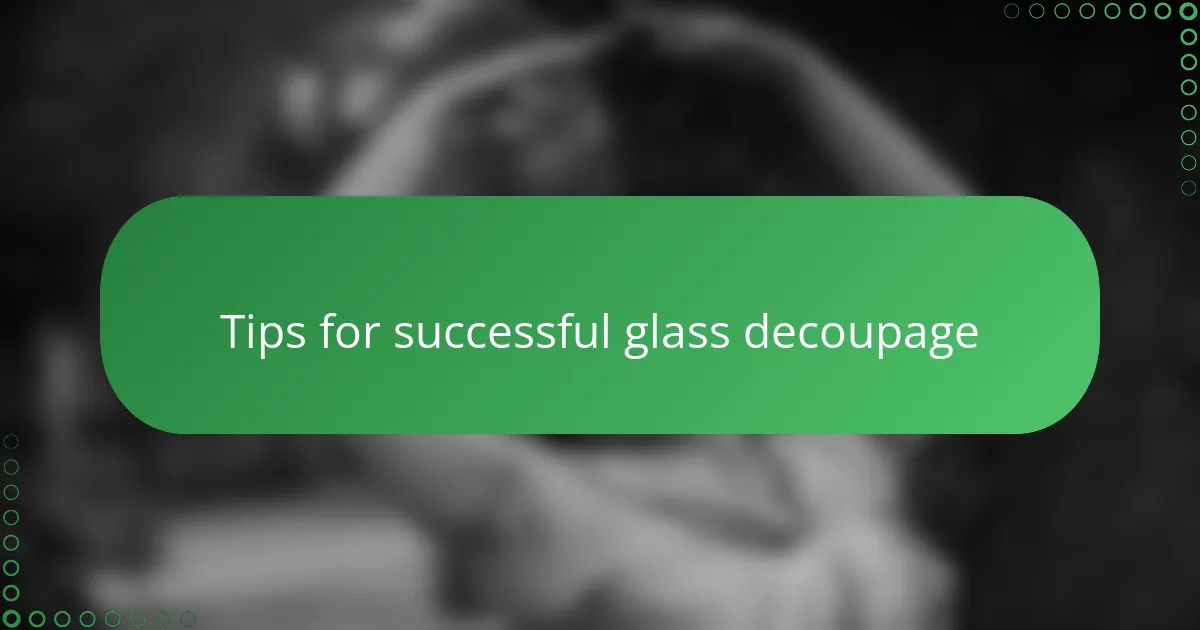Key takeaways
- Handmade paper crafts combine creativity and personal expression, offering endless possibilities with simple materials.
- Decoupage on glass transforms ordinary objects, emphasizing the importance of preparation and using the right materials for a flawless finish.
- Patience is key in the decoupage process, particularly during drying times and applying adhesive in thin layers to avoid imperfections.
- Overcoming challenges in crafting fosters growth and appreciation for the process, making each completed project more rewarding.

Introduction to handmade paper crafts
Handmade paper crafts have always fascinated me because they transform simple materials into something truly unique and meaningful. Have you ever held a piece of paper and imagined the countless possibilities it holds? From delicate flowers to intricate collages, the art of crafting with paper connects creativity with everyday life in such a personal way.
There’s something deeply satisfying about working with your hands and watching as your ideas come to life. I remember the first time I folded a piece of handmade paper—it felt like I was part of a tradition that goes back centuries. Each texture and color invites me to explore new techniques and tells its own story.
What makes handmade paper crafts so special is the blend of patience and spontaneity they require. You never quite know how the final piece will turn out, which keeps the process exciting. Isn’t it wonderful that such simple materials can inspire endless creativity?

Understanding decoupage on glass
Decoupage on glass has always intrigued me because it merges the delicate world of paper crafts with the smooth, transparent surface of glass. I found it fascinating how layering paper onto glass can breathe new life into ordinary objects, turning them into personalized treasures. Have you ever wondered how a simple paper cutout can cling so seamlessly to glass, almost as if it were painted on?
One thing I quickly learned is that understanding how to prepare both the glass surface and the paper is key. You need to think beyond just sticking a design; it’s about creating a bond that lasts without bubbles or wrinkles. I recall my first project where I didn’t clean the glass properly, and those little imperfections taught me how crucial this step really is.
What really stands out to me about decoupage on glass is the interplay of transparency and texture. When light passes through the glass with the paper design layered on it, it creates an effect that feels almost magical. Have you experienced that moment when your creation suddenly lights up a room? That’s the kind of reward that keeps me coming back to this craft.

Essential materials for decoupage
When I first started decoupaging on glass, gathering the right materials felt like assembling a small but essential toolkit. Of course, you need quality glass pieces as your canvas, but the real magic happens with the paper—lightweight napkins or tissue paper work best because they conform easily to the glass surface and avoid bulky layers.
Then there’s the adhesive, which I quickly realized isn’t just glue; it’s a special decoupage medium that dries clear and flexible. Have you ever tried using regular glue only to see your design peel or wrinkle? That sticky lesson taught me the value of using the right finish for a smooth, lasting result.
Besides these basics, a few extras like soft brushes and a small sponge come in handy for gently smoothing out bubbles or wrinkles. I remember feeling frustrated the first time a bubble marred my work, but with patience and the right tools, I learned how to create that flawless finish we all aspire to achieve.

Step-by-step decoupage process
The first time I approached the decoupage process, I realized that taking it step-by-step truly makes all the difference. Starting with a clean, grease-free glass surface feels like laying a solid foundation—without that, even the best paper design won’t adhere properly. Have you ever tried skipping this step and ended up with frustrating bubbles or peeling edges? I certainly have, and it taught me to never rush the preparation.
Applying the adhesive is where patience really pays off. I like to brush on a thin, even layer of decoupage medium onto the glass, then carefully place my paper design while it’s still tacky. Gently smoothing from the center outward helps prevent wrinkles, but sometimes I still catch myself holding my breath, hoping no air pockets sneak in—that moment is both nerve-wracking and exciting.
Once the design is in place, I let everything dry fully before sealing it with a couple more coats of the medium. This protects the paper and gives the glass a smooth, glossy finish that feels gratifying to the touch. From experience, I’ve found that waiting patiently between layers is key to avoiding a sticky or uneven surface—trust me, it’s worth the extra time for that polished look.

Tips for successful glass decoupage
One tip that changed my whole approach to glass decoupage was learning to always clean the glass thoroughly before starting. I used to skip this step, thinking it was no big deal, only to find my paper peeling off after a few days. Do you know that satisfying feeling when your paper sticks perfectly, no bubbles or dust in sight? That’s the result of a spotless surface.
Another thing I’ve discovered is to apply the adhesive in thin, even layers. At first, I was heavy-handed, which caused wrinkles and a cloudy finish. It took some patience and trial to get the right balance, but now I enjoy the calming rhythm of brushing on the medium just right, almost like a mini meditation. Have you ever felt that sense of calm creativity in your craft?
Finally, don’t rush the drying times between layers. I’ve learned that good things really do come to those who wait. Skipping this made my projects sticky or uneven, which was frustrating. Taking the time to let each coat dry fully gives your decoupage a smooth, professional look that’s incredibly satisfying to see and touch. What’s more rewarding than holding a finished piece that looks as good as it feels?

Common challenges and solutions
One challenge I often faced was dealing with wrinkles and bubbles under the paper. I remember the frustration of seeing all my careful cutting get marred by tiny air pockets. What helped me was gently smoothing from the center outwards with a soft brush, which really made a difference in getting that flawless finish.
Another tricky part is choosing the right adhesive. Early on, I used regular glue and quickly learned it wasn’t made for glass decoupage — my designs started peeling off too soon. Switching to a decoupage medium that dries clear and flexible was a game changer; it not only held everything firmly but also preserved the delicate paper texture beautifully.
Patience is probably the biggest solution to countless hiccups. I used to rush the drying times, eager to see the final result, only to be disappointed by sticky spots or uneven layers. Taking time between coats allowed me to achieve that smooth and glossy surface I now treasure, turning each project into a calming and rewarding experience. Have you ever felt that little moment of pride when your piece looks exactly how you imagined? That’s worth every extra minute of waiting.

My personal decoupage experience
When I first tried decoupaging on glass, I was both excited and a bit nervous. I remember holding that delicate paper against the smooth glass, wondering if it would stick without bubbling or tearing. That moment of pressing it carefully and watching it take shape felt like discovering a secret trick in a long-lost art.
There was one project where I layered several colors and patterns, and when the light hit it just right, I felt a genuine thrill—like I’d created a tiny window into a different world. Have you ever experienced that unexpected joy when something you crafted suddenly feels alive? That’s exactly what happened, and it’s what makes me keep coming back to this technique.
Of course, not every attempt was perfect. I’ve had my share of wrinkles and sticky edges, which initially frustrated me. But looking back, those “mistakes” taught me patience and attention to detail—two things I now cherish in this craft. Isn’t it amazing how overcoming small challenges makes the finished piece even sweeter?
